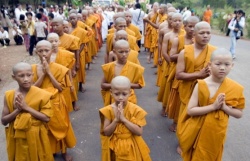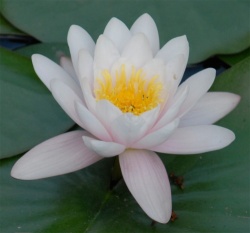Nondual polytheistic pluralism
By Lex Hixon
The deity Manjusri appeared in dreamvision to the great Buddhist teacher Atisa, revealing to him that the school of prasangika madhyamika contained the fullest expression of truth. This is a good example of the peculiar functioning of tantric, or nondual, theism: the deity appears and reveals a truth in which all concept of deity is undercut. Due in some measure to the vigor of Atisa (and the grace of Manjusri), the prasangika madhyamika became the universal basis of Tibetan Buddhism. One could translate prasangika as "avoidance" - the avoidance of assertion through the discovery of the void or non-binding nature of any particular assertion. Leaving aside the fact that followers of the prasangika madhyamika often become strangely assertive, the prasangika approach provides a void basis for the free pluralism of tantric theistic practice. When there can be no binding system of assertions, there is no limit to the number and nature of revelatory deities which can flourish in emptiness without holding rival ontological claims; the function of these deities, which are nonentities, is to reveal the unbound, free-form nature of all form, to reveal truth. The vajrayana, or "way of tantra," is theistic and pluralistic. Theism and pluralism are the two issues we want to discuss briefly.
Among the forms of theism, tantric theism is indeed somewhat unconventional because it springs out of the nondual insight which clearly recognizes no differences in essence between worshipper and worshipped. But it is not merely a provisional theism, cleverly designed to destroy itself, because the deities do not become obsolete to enlightened practitioners. Atisa did not consider Manjusri simply as his own mind revealing to him the truth of prasangika madhyamika. Manjusri is undoubtedly buddha-mind, but so is the Crab Nebula, and as no astronomer considers this giant cluster of stars a fiction or projection of his own mind, in the same sense, no tantric practitioner considers his chosen deity a fiction or projection of his own mind. Actually, it is the deities who project us, rather than we who project the deities.
Also, the tantric practitioner does not seek to merge with the deity in a monistic sense. There is a proud exhilaration of nonduality of essence between practitioner and deity, but the reverential relationship with the deity is maintained and deepened. The deity is not a cardboard container for the nectar of nondual insight or bliss-void, to be thrown away after the nectar is consumed. The deity is a permanent expression of insight, emptiness, and bliss. Actually, it is the practitioner who is a cardboard container, whose body and mind are eventually thrown away in death. The tantric experience of theistic relationship in the minds of nonduality is perhaps best expressed by the symbol of sexual union. The playful twoness is an essential expression of the nondual bliss. But the image of biological human sexuality is not entirely apt because it brings together two elements, the male and the female, into ecstatic union, whereas the Great Bliss of tantra is not a joining together but the discovery of an innate, natural nonduality which playfully projects from itself the elements of male and female, worshipper and worshipped. The play does not create the nonduality; the nonduality generates the play. Theism is the play between worshipper and worshipped, seeker and sought; many spiritual traditions accept the imagery of lover and beloved - though often not in the overtly sexual mode - as the most accurate description of the play. For advanced practitioners, this play deepens and intensifies. What becomes realized cannot be put into words. To state it as a philosophical doctrine of nondualism, qualified nondualism, or dualism, and then to argue about it, is somewhat beside the point. We can only say that intimacy intensifies to the point of identity, steps back to enjoy itself, and then reintensifies in a kind of endless sexual rhythm. This structure and rhythm can be discerned even in such an overtly nontheistic atmosphere as zen koan practice. The zen master Hakuin had five ecstatic great enlightenment experiences in this loveplay with the truth. Even in the absence of a formal deity, the ecstatic spiritual play which is theism manifests itself, not abstractly through concepts, but concretely as divine-human energies. The guru, lama, roshi or tzaddik often takes the place of a transcendent deity-form as the beloved. All worshippers or seekers (those of Dionysus, Christ, Kali, Allah, Bodhi, Brahman, Tao, Torah and on and on) are channels for the theistic playfulness of the truth, which is itself void of structure, yet full of energy.
This brings us to the issue of tantric pluralism. Countless sadhanas or formal worship of deities are recorded side by side in the Buddhist sadhanamala, or "garland of sadhanas." There is no sense that the practice of one deity is fundamentally superior or contradictory to that of another, yet at the same time, there is a fierce mood of total dedication of one's energy to the particular sadhana in which one is engaged. The fullness and accuracy of practice is considered a life-and-death matter; partial and casual experimentation with several sadhanas, serially or simultaneously, would be unthinkable for the serious tantric practitioner. Thus tantric pluralism is very far from the uninformed, unprepared for, uncommitted, and therefore irresponsible experimentation with various spiritual practices which are coming into fashion in the West today as a kind of cross-cultural theater of religious liberalism. But distortions of the pluralistic approach should not blind us to its essential truth. Tantric pluralism is based on the prasangika madhyamika: if no formulation of the Real is accepted as accurate (simply because of its very nature as formula), then countless formulations can be freely allowed to exist side by side as vehicles for the awakening to the Real. One does not awaken to the non-formulatability of the Real by simply and abstractly contemplating the assertion of its non-formulatability (which is itself nothing but another formulation). One realizes nonformulatability concretely by penetrating deeper and deeper into one or more particular formulations, by living them with total intensity. Why not regard all the authentic spiritual traditions of the planet as a sadhanamala, a gigantic garland of sadhanas? Each of these sadhanas, when undertaken with total dedication and thorough preparation, leads to an overtly or covertly nondual intimacy with a particular mode of playfulness, energy-current, or deity-form of reality itself, if one has the courage and strength to pursue the sadhana to its root or to surrender to it with complete abandon, rather than adopting the practice in a mild, conventional manner.
Sadhanas are like children. One can have several children, fully loving and nurturing each one; in fact, an only-child does not always prosper psychologically. But here we must point out a common error in the understanding of spiritual pluralism. Religious traditions do not "say the same thing in different languages." They each say something unique. Nor do the spiritual exercises of the various traditions "lead to the same ultimate experience." Enlightened persons from different streams of spiritual practice do not readily agree on the nature of realization. Each enlightenment is a unique flowering of truth. Pluralism goes right down to the root; it is radical pluralism. All spiritual practices are independent currents or tides in one planetary ocean. The Gulf Stream is not equivalent to or interchangeable with some current in the Indian Ocean or some tide along the coast of Japan.
Because of the tremendous development of planetary communications, radical spiritual pluralism is emerging now for the first time in the history of human civilizations as a concrete cultural possibility. But if it emerges simply on the cultural plane, it becomes merely a form of diplomacy or theater, not a transforming realization of nonduality. Pluralism must discover its own spiritual authenticity, and this authenticitv is available through the prasangika madhyarru:ka and the practice of tantra (but not exclusivelv there; the potentiality for it exists in each spiritual current). The fact that Indian culture has provided useful initial modes for spiritual pluralism can be seen as a confirmation of the potency of tantric pluralism, because, as Trungpa Rinpoche and other tantric practitioners and scholars have observed, there is little spiritual practice on the Indian subcontinent which has not been subtly imbued with tantric influences. On the Indian subcontinent religious paths are indeed regarded as a sadhanamala, although bitter quarreling among adherents of the various sects is also prevalent. We have to carry this attitude of the garland of sadhanas further and develop it more consciously, dissolving the idea that Christianity and Islam, Hinduism and Buddhism are solid, mutually exclusive entities; religions are not solid entities, any more than cultures or nations are. When the nondual insight into emptiness has revealed the void, non-obstructing nature of all categories, then various cultural, philosophical, and religious forms can stay in play, now transparent and therefore free from mutual antagonism.
The countless deity-forms are not to be discarded after they are discovered to be innately transparent to the formless truth. A harmonious polycultural world-view can be created with these transparent forms - a polytheism which is nondual. This is the vajra path as it manifests in the planetary age, moving in new cultural directions with the same nondual insight and with the same deities, such as the marvelous Mahakala-Mahakali, who appear revealing a truth in which various spiritual traditions flourish even as the very concept of separate traditions is undercut.


